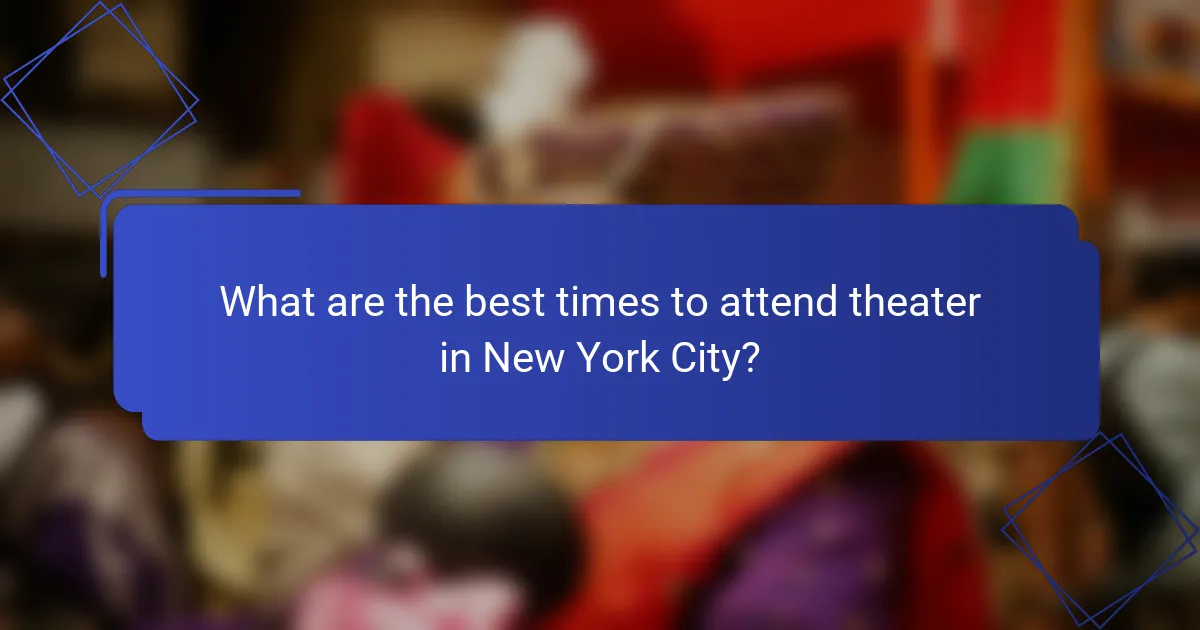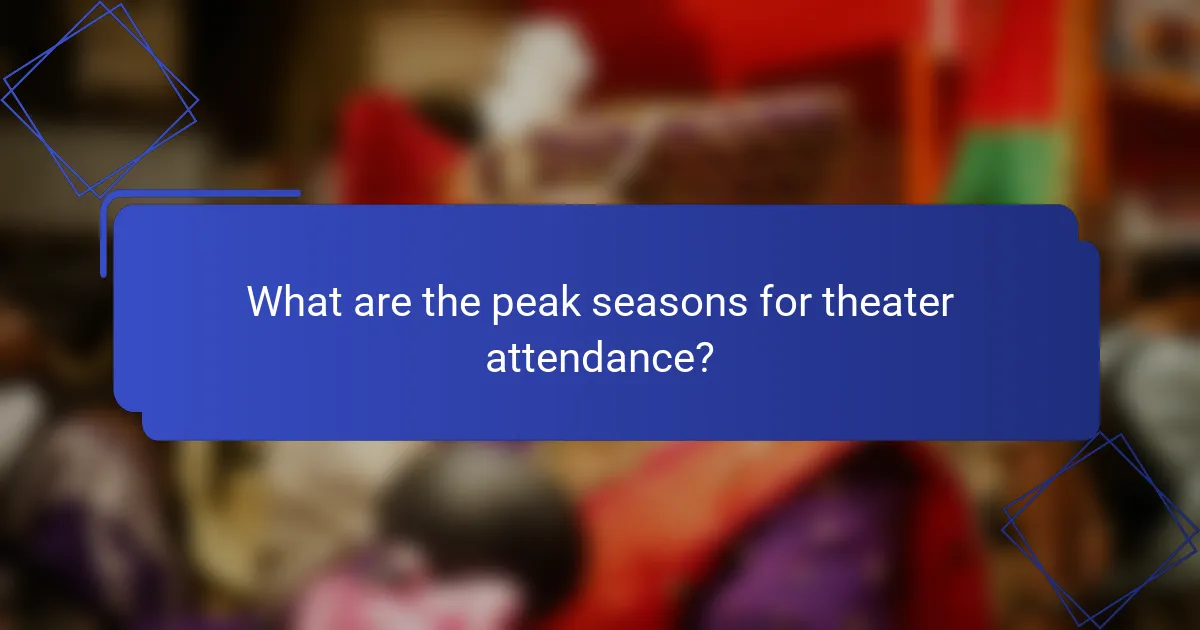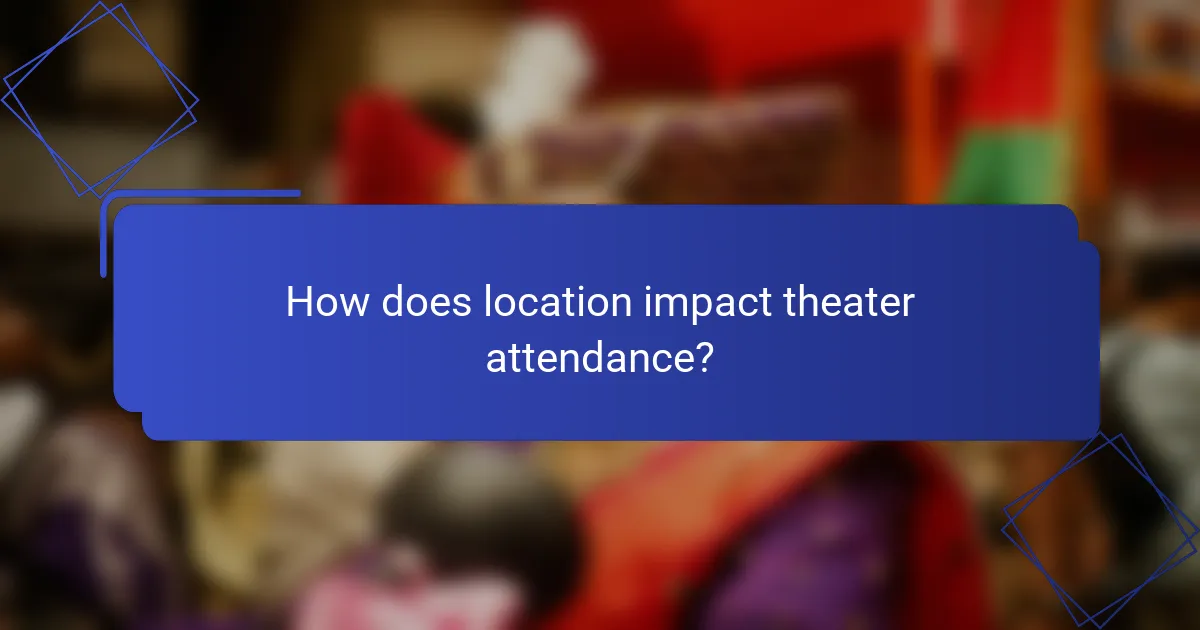Choosing the best times to attend theater in New York City can enhance your experience, as weekends, weekday evenings, and matinee performances cater to various audience demographics. Understanding the preferences of different age groups and income levels can help you select the ideal time for your visit, ensuring a more enjoyable outing. Additionally, peak seasons like the holiday period and summer months draw larger crowds, making them prime opportunities for both theaters and attendees seeking entertainment.

What are the best times to attend theater in New York City?
The best times to attend theater in New York City typically include weekends, weekday evenings, and matinee performances. These times cater to different audience demographics and preferences, making it essential to choose based on your schedule and the type of experience you seek.
Weekends for popular shows
Weekends are prime time for popular shows in New York City, as many people have more free time to enjoy theater. Saturday evenings often see the highest attendance, with audiences eager to experience the latest hits. It’s advisable to book tickets in advance, especially for well-known productions, as they can sell out quickly.
Sunday matinees also attract families and those looking for a more relaxed experience. Consider arriving early to enjoy pre-show dining options in the bustling theater district.
Evenings for after-work audiences
Evening performances during the week cater primarily to after-work audiences, making them ideal for professionals looking to unwind. Shows typically start around 7:00 PM or 8:00 PM, allowing for a post-work dinner before the performance. This timing is popular for both weekday and weekend shows.
However, be mindful of rush hour traffic and subway delays when planning your trip. Arriving at least 30 minutes early is recommended to ensure a smooth entry and to enjoy the theater’s ambiance.
Matinees for families
Matinee performances, usually held on Wednesdays and Saturdays, are perfect for families with children. These shows often start around 2:00 PM, making it easier for families to attend without disrupting bedtime routines. Matinees tend to be less crowded than evening shows, providing a more relaxed atmosphere.
When attending with children, check for age recommendations and consider shows that are specifically designed for younger audiences. This ensures an enjoyable experience for both kids and parents alike.

How do audience demographics influence theater attendance?
Audience demographics significantly impact theater attendance patterns, as different age groups and income levels exhibit distinct preferences and behaviors. Understanding these factors can help theaters tailor their offerings and marketing strategies to attract diverse audiences.
Age groups and preferences
Age plays a crucial role in determining theater attendance, with younger audiences often favoring contemporary productions and musicals, while older demographics may prefer classic plays or dramas. For instance, millennials and Gen Z tend to enjoy immersive experiences and interactive performances, whereas baby boomers might gravitate towards traditional storytelling.
The timing of performances can also be influenced by age. Younger audiences may prefer evening shows or weekend matinees, while older patrons might opt for early evening or weekday performances to avoid crowds.
Income levels and spending habits
Income levels directly affect theater attendance, as higher-income individuals are generally more willing to spend on premium seats and special events. Conversely, those with lower incomes might seek discounted tickets or attend community theater productions. This disparity can shape the types of shows that are produced and marketed.
Additionally, spending habits vary across income brackets. For example, affluent attendees may be more inclined to purchase season passes or VIP packages, while budget-conscious individuals often look for promotional offers or group discounts. Theaters can benefit from understanding these spending patterns to create targeted pricing strategies.

What are the peak seasons for theater attendance?
The peak seasons for theater attendance typically occur during the holiday season and summer months. These times attract larger audiences due to festive events and outdoor performances, making them ideal for both theaters and patrons looking for entertainment.
Holiday seasons for festive shows
Holiday seasons, particularly around Christmas and New Year, are prime times for theater attendance. Many theaters showcase festive productions, such as classic musicals and seasonal plays, which draw in families and tourists alike.
During this period, ticket sales can increase significantly, often reaching full capacity. It’s advisable to book tickets well in advance, as popular shows may sell out quickly.
Summer for outdoor performances
Summer is another peak season for theater, especially for outdoor performances. Many cities host festivals and open-air shows, allowing audiences to enjoy theater in a more relaxed and social atmosphere.
These performances often feature a mix of classic plays, contemporary works, and family-friendly productions. Attendees should consider factors like weather and seating arrangements when planning their visit, as outdoor venues can vary widely in comfort and amenities.

How do ticket prices affect attendance?
Ticket prices significantly influence audience attendance at theater performances. Higher prices can deter some potential attendees, while discounts can attract budget-conscious individuals, creating a diverse audience demographic.
Discount days for budget-conscious audiences
Many theaters offer discount days to appeal to budget-conscious audiences, often providing tickets at reduced prices on specific weekdays or during off-peak times. These promotions can range from 20% to 50% off the regular ticket price, making theater more accessible to a wider audience.
For example, a theater might designate Tuesday evenings as discount nights, encouraging those who may not typically afford tickets to attend. This strategy not only increases attendance but also fosters a loyal customer base that appreciates the affordability.
Premium pricing for high-demand shows
Conversely, high-demand shows often implement premium pricing strategies, where ticket prices are elevated due to popularity or limited availability. This can lead to ticket prices that are significantly higher, sometimes exceeding standard rates by 30% or more.
Theaters may also introduce tiered pricing, where seats closer to the stage are priced higher than those further back. This approach maximizes revenue while catering to audiences willing to pay more for an enhanced experience. It’s essential for theaters to balance premium pricing with audience accessibility to maintain a diverse attendance.

What are the trends in audience preferences for theater?
Current trends in audience preferences for theater indicate a growing demand for innovative and engaging experiences. Factors such as immersive storytelling and diverse narratives are increasingly shaping the way audiences choose to engage with theatrical performances.
Increased interest in immersive experiences
Audiences are gravitating towards immersive theater, where they can interact with the performance environment. This trend allows viewers to feel like active participants rather than passive observers, enhancing their overall experience.
Productions that incorporate elements like audience interaction, unconventional staging, and sensory engagement are particularly popular. Examples include site-specific performances and shows that break the fourth wall, creating a more personal connection with the audience.
Preference for diverse storytelling
There is a marked preference for stories that reflect a variety of cultures, identities, and experiences. Audiences are seeking narratives that resonate with their own lives or broaden their perspectives on different communities.
Theater companies are responding by programming works from diverse playwrights and adapting stories that highlight underrepresented voices. This shift not only attracts a wider audience but also fosters a richer cultural dialogue within the theater community.

How does location impact theater attendance?
Location significantly influences theater attendance by affecting accessibility and the presence of nearby attractions. Urban areas typically see higher attendance rates due to better transportation options and a concentration of cultural venues.
Accessibility of venues in urban areas
Urban theaters often benefit from public transportation systems, making them more accessible to a larger audience. Cities with extensive subway or bus networks allow patrons to reach venues quickly, while those in rural areas may face longer travel times and limited options.
Additionally, urban venues tend to have more parking facilities, which can ease the experience for those driving. However, parking costs can vary widely, with urban areas often charging higher rates compared to suburban locations.
Tourist attractions boosting attendance
Theater attendance in cities with prominent tourist attractions tends to increase, as visitors often seek entertainment options during their stay. For instance, theaters near landmarks or popular museums can draw in tourists looking to enhance their cultural experience.
Moreover, cities that host festivals or events can see spikes in attendance during those times. The combination of local interest and tourist engagement can lead to sold-out shows and increased revenue for theaters.

What are the best practices for marketing to theater audiences?
Effective marketing to theater audiences involves understanding their demographics and preferences. Tailoring strategies to engage specific audience segments can significantly enhance ticket sales and attendance.
Targeted advertising strategies
Targeted advertising strategies focus on reaching specific demographics that are most likely to attend theater performances. This can include analyzing data on age, location, and interests to create tailored ads that resonate with potential attendees.
Utilizing platforms like Google Ads or Facebook Ads allows marketers to set parameters for their campaigns, ensuring that ads are shown to the right audience. For example, targeting young adults for contemporary shows or families for matinee performances can yield better results.
Utilizing social media for engagement
Social media is a powerful tool for engaging theater audiences and building a community around productions. Platforms like Instagram and Twitter can be used to share behind-the-scenes content, cast interviews, and audience testimonials, creating excitement and anticipation.
Encouraging user-generated content, such as photos from performances or reviews, can further enhance engagement. Offering incentives, like discounts for sharing posts or tagging the theater, can also drive interaction and increase visibility among potential attendees.

What emerging trends are shaping the future of theater attendance?
Emerging trends in theater attendance are heavily influenced by technology, changing audience demographics, and evolving preferences. These factors are reshaping how performances are delivered and experienced, making theater more accessible and engaging for diverse audiences.
Integration of technology in performances
The integration of technology in theater performances enhances the overall experience for audiences. This includes the use of augmented reality (AR), virtual reality (VR), and advanced sound and lighting systems, which create immersive environments that captivate viewers.
For instance, some productions now incorporate live streaming options, allowing audiences to enjoy performances from home. This trend has become increasingly popular, especially during and after the pandemic, as it accommodates those who may have mobility issues or live far from theaters.
When considering technology integration, theaters should balance innovation with traditional elements to maintain the essence of live performance. Engaging with audience feedback can help determine which technologies resonate best and enhance the overall experience.



